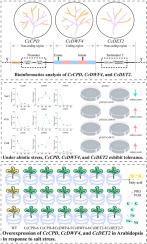山核桃油菜素内酯合成基因CcCPD/CcDWF4/CcDET2通过多方面的调控机制增强山核桃对盐胁迫的适应能力
IF 5.7
2区 生物学
Q1 PLANT SCIENCES
引用次数: 0
摘要
山核桃(Carya cathayensis)是一种具有重要经济价值的珍贵木本油料树种,由于土壤盐碱化,其主产区的产量经常下降。油菜素内酯(BRs)是调控植物生长发育和胁迫反应的重要激素,在增强植物抗逆性中起着关键作用。然而,盐胁迫下华北菜BR生物合成关键基因的功能和机制尚未完全阐明。本研究以华夏香椿BR生物合成关键基因CcCPD、CcDWF4和CcDET2为研究对象,系统研究了它们的基本特征,包括进化保守性、蛋白特性、亚细胞定位和组织表达模式。研究结果还表明,这些基因在盐、干旱和寒冷胁迫下表现出动态表达模式,表明它们可能通过调节BR生物合成参与抗逆性。通过酿酒酵母的异源表达和拟南芥的过表达功能验证进一步证实了这些基因在胁迫应答中的作用,揭示了它们在耐盐性中的多方面调控机制。这些机制包括维持离子稳态,增强抗氧化能力和渗透调节,以及通过脂肪酸代谢潜在的重塑膜完整性。本研究初步揭示了杉木BR生物合成基因增强耐盐性的机制,为耐盐木本植物分子育种提供了重要靶点。本文章由计算机程序翻译,如有差异,请以英文原文为准。

Brassinosteroid synthesis genes CcCPD/CcDWF4/CcDET2 in Carya cathayensis enhance resilience to salt stress through multi-faceted regulatory mechanisms
Hickory (Carya cathayensis), a valuable woody oil species with considerable economic importance, often suffers from reduced yields in its primary production regions due to soil salinization. Brassinosteroids (BRs), essential hormones that regulate plant growth, development, and stress responses, play a pivotal role in enhancing plant stress resistance. However, the functions and underlying mechanisms of key genes involved in BR biosynthesis in C. cathayensis under salt stress have yet to be fully elucidated. This study centered on the key BR biosynthetic genes CcCPD, CcDWF4, and CcDET2 in C. cathayensis, systematically examining their fundamental characteristics, including evolutionary conservation, protein properties, subcellular localization, and tissue expression patterns. Our findings also revealed that these genes exhibited dynamic expression patterns in response to salt, drought, and cold stresses, indicating their potential involvement in stress resistance through the modulation of BR biosynthesis. Functional validation through heterologous expression in Saccharomyces cerevisiae and overexpression in Arabidopsis thaliana further substantiated the roles of these genes in stress responses and unveiled their multifaceted regulatory mechanisms in salt tolerance. These mechanisms involve the maintenance of ion homeostasis, enhancement of antioxidant capacity and osmotic adjustment, as well as potential remodeling membrane integrity via fatty acid metabolism. This study provides preliminary insights into the mechanisms by which BR biosynthetic genes in C. cathayensis enhance salt tolerance, offering vital targets for the molecular breeding of salt-tolerant woody plants.
求助全文
通过发布文献求助,成功后即可免费获取论文全文。
去求助
来源期刊
CiteScore
11.10
自引率
3.10%
发文量
410
审稿时长
33 days
期刊介绍:
Plant Physiology and Biochemistry publishes original theoretical, experimental and technical contributions in the various fields of plant physiology (biochemistry, physiology, structure, genetics, plant-microbe interactions, etc.) at diverse levels of integration (molecular, subcellular, cellular, organ, whole plant, environmental). Opinions expressed in the journal are the sole responsibility of the authors and publication does not imply the editors'' agreement.
Manuscripts describing molecular-genetic and/or gene expression data that are not integrated with biochemical analysis and/or actual measurements of plant physiological processes are not suitable for PPB. Also "Omics" studies (transcriptomics, proteomics, metabolomics, etc.) reporting descriptive analysis without an element of functional validation assays, will not be considered. Similarly, applied agronomic or phytochemical studies that generate no new, fundamental insights in plant physiological and/or biochemical processes are not suitable for publication in PPB.
Plant Physiology and Biochemistry publishes several types of articles: Reviews, Papers and Short Papers. Articles for Reviews are either invited by the editor or proposed by the authors for the editor''s prior agreement. Reviews should not exceed 40 typewritten pages and Short Papers no more than approximately 8 typewritten pages. The fundamental character of Plant Physiology and Biochemistry remains that of a journal for original results.

 求助内容:
求助内容: 应助结果提醒方式:
应助结果提醒方式:


